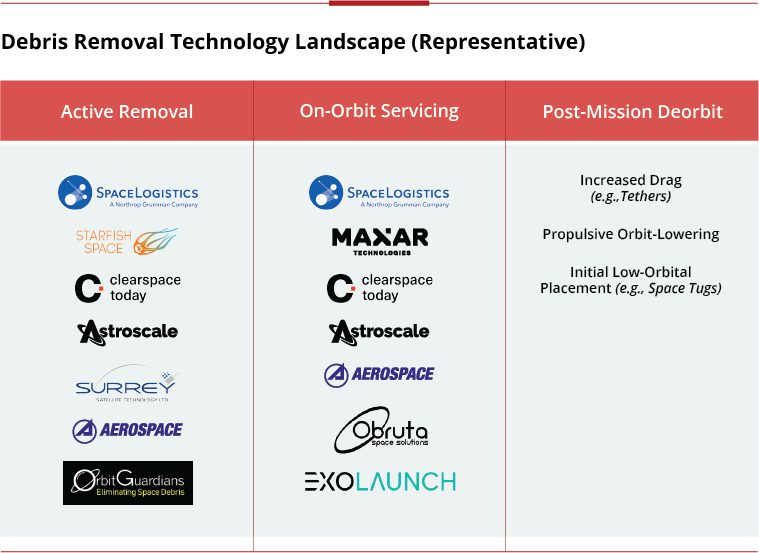Building the Business Case for Space Debris Removal

There is no shortfall of industry discussion regarding the rapidly increasing amounts of space traffic. With roughly 16,000 satellites expected to be launched from 2021-2025, it is widely recognized that the saturated space environment poses risks to sustaining safe spaceflight operations.
Despite industry’s general awareness, progress towards establishing a framework for space debris removal, on-orbit servicing, and post-mission deorbit as key tenets of space sustainability has been challenged by shifting priorities of domestic and international governing agencies.
In effect, civil and federal operators continue to self-regulate their space operations, often leveraging varying data sources and risk criteria to determine their need for collision avoidance maneuvers. With the growth in objects in space, debris-generating collisions and close-calls have become increasingly frequent.
This year alone, a hole was discovered in the ISS likely to be caused by space debris, SpaceX Crew-2 faced a conjunction threat from space junk, and Starlink and OneWeb underwent a forced maneuver to avoid a potential collision.
While these operational threats are likely to become a commonality, governing bodies have shown little indication of taking the lead on deploying space debris removal and remediating technologies in the near future.
Recent comments from Major General DeAnna Burt, the Vice Commander of Space Force’s Space Operations Command, suggest that the US government supports private development of service-based debris remediation technologies, which are largely in the early testing stages.
While Burt claims “there’s a business case for debris removal for industry,” significant developments need to settle across industry in order to prove out this claim.
Space debris removal technologies such as space tugs and junk collectors currently remain in the testing and development stages, with limited access to a broad range of customers. To expand the customer interest of these technologies, a number of sustainability factors need to gain traction industry-wide.
Understanding how these factors can develop the business case for various space debris removal services is essential for industry stakeholders.

Factors that Increase Space Debris Removal Adoption
Liability Insurance
The US currently requires satellite operators to be insured for $500M in damages caused by third parties and an additional $100M in coverage for damage claims from the government.
Payment to the US government, however, is subject to a limit of $1.5B, meaning insurance would only cover 40% of claims, potentially leaving satellite operators in severe financial distress if collisions were to occur. As risk assessments and exclusion clauses continue to make insurance offerings increasingly unfavorable for insurance seekers, operators will seriously consider deorbiting and cleanup services that allow them to avoid paying insurance over a longer time horizon.
Sustainability Ratings
The World Economic Forum’s recent development of a Space Sustainability Rating system currently provides operators with sustainability scores based on deorbit plans, collision maneuvers, and data sharing.
While the rating system is used on a voluntary basis by operators, federal adoption of a Space Sustainability Rating system will likely unify self-regulation of space activities.
In doing so, the system would incentivize operators to incorporate debris remediating plans prior to entering orbit, akin to an ESG score, while also playing a role in operators’ insurance costs, investor backing, and customer base.
Maneuverability Requirements
As domestic regulatory stakeholders progress on policy requirements regarding maneuverability for constellations above a certain height and size, as well as end-of-life disposal requirements, operators may react by leveraging in-orbit propulsion capabilities for maneuvers, deorbit servicing, and mitigating space debris removal services.
Space debris removal providers could first see mega constellation operators adopt low-cost maneuvers and debris mitigation services in order to adapt to adjusting regulatory requirements, with regulatory iterations underway for updated maneuverability requirements for constellations over a certain size.
Conclusion
Providers’ ability to react to shifting operational requirements and trending sustainability initiatives is crucial to forming and maintaining long-standing business positions within industry, all the while working towards an active solution for the growing debris problem.
While federal and commercial operators recognize the growing space debris problem, strategic priorities of preparing for potential conflicts and innovating commercial offerings will continue to saturate the domain.
As private development of space debris removal services receive additional support from both private and public operators, stakeholders should keep a close eye on the steps required for providers to bridge the gap between nascency and profitability.
Subscribe to the Avascent Apogee
We invite you to subscribe to the Avascent Apogee – Insights delivered to your inbox on critical issues shaping the Space industry’s future.



